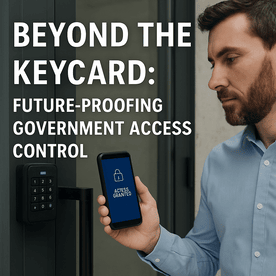
Keycards and fobs have long been the standard in access control for city buildings. They're familiar, cost-effective, and—until recently—good enough.
But as public facilities face increasingly complex security demands, more municipalities are asking:
Is our current access control system keeping up with the way we work today?
Between hybrid workforces, shared-use spaces, growing compliance requirements, and emerging digital threats, traditional badge systems are beginning to show their age.
In this article, we explore what comes after keycards, and how forward-thinking public agencies can future-proof their access control systems to protect people, infrastructure, and public trust.
k
k
Why Keycards Alone Are No Longer Enough
Keycards were designed for an era when buildings had predictable access patterns and limited integration needs. But today’s municipal buildings are:
-
Used by multiple departments and contractors
-
Frequently open to the public
-
Subject to stricter compliance and audit requirements
-
More vulnerable to lost credentials, cloned cards, and unauthorized duplication
If your access control system hasn’t evolved past basic badge entry, you may be exposing your facility to unnecessary risk and missing out on critical capabilities.
k
k
What It Means to Future-Proof Your Access Control
Future-proofing doesn’t mean chasing every new technology. It means choosing access control solutions that are:
-
Flexible to support different user types
-
Scalable across buildings and departments
-
Compliant with federal standards like NDAA and CJIS
-
Integrated with surveillance, emergency systems, and HR platforms
-
Remote-ready to accommodate hybrid staff and cloud oversight
At SSP, we help municipalities transition from legacy systems to modern, centralized platforms that support the next generation of government facility security systems.
k
k
Modern Alternatives to Legacy Keycards
Here’s what’s replacing the plastic badge:
1. Mobile Credentials
Instead of carrying a physical card, staff can unlock doors using a secure app on their smartphone.
Why it matters:
-
Faster onboarding and offboarding
-
Remote credential management
-
Two-factor authentication options
-
Lower long-term costs (no reprinting cards)
Use case: A city employee working across multiple buildings can be granted access remotely for the day—no need to issue and return a physical badge.
k
k
2. Encrypted QR Codes and Visitor Passes
These temporary, scannable codes can be issued for scheduled guests, vendors, or contractors.
Why it matters:
-
Limits access to specific times, doors, and dates
-
Avoids handing out general-use proximity cards
-
Tracks guest activity for compliance and review
Use case: A maintenance contractor receives a one-day QR code with access to only the utility room at the wastewater facility—nowhere else.
k
k
3. Biometric Readers (Where Appropriate)
While not ideal for every setting, fingerprint or facial recognition readers can be highly effective in restricted zones like evidence rooms or IT closets.
Why it matters:
-
Credentials can’t be lost, stolen, or shared
-
Audit trails are tied directly to individuals
-
Adds another layer of authentication for sensitive areas
Compliance note: All biometric deployments must follow data privacy laws and should be evaluated based on local policy and risk level.
k
k
Key Features to Include in a Future-Ready Access Control System
Regardless of which credential types you use, future-proof systems should also include:
-
Cloud-based management for multi-site oversight
-
Role-based access that aligns with job titles, not just departments
-
Real-time alerts for door props, forced entry, or unusual behavior
-
Integration with video surveillance for visual confirmation of events
-
Automated credential expiration and audit logs for compliance
At SSP, we help agencies configure these features based on their building layout, staffing model, and operational needs—without overcomplicating the system.
k
k
A Phased Approach to Modernization
You don’t need to rip out your entire system to start moving forward.
We recommend a phased rollout:
-
Start with high-risk or high-traffic buildings
-
Introduce mobile credentials for select departments
-
Standardize credential policies citywide
-
Build integrations with surveillance and emergency platforms
-
Evaluate future enhancements like biometrics or visitor kiosks
Modern access control is not a one-size-fits-all solution. It’s a tool for enabling smarter, safer, and more responsive government operations.
k
k
Final Thoughts
The future of public sector access control isn’t plastic—it’s programmable, trackable, and built for flexibility. If your agency is still relying solely on keycards, it may be time to explore what’s next.
SSP helps government agencies transition smoothly to secure, compliant, and scalable systems—without disrupting daily operations or stretching your budget.
Ready to Take the Next Step?
See how SSP helps municipalities protect their people and infrastructure with modern access control solutions.
Contact us to schedule a free facility assessment or consultation.


